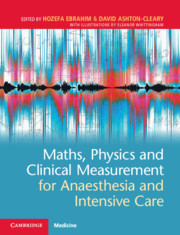62 results
Chapter 2 - Basic Physics and Electronics
-
-
- Book:
- Maths, Physics and Clinical Measurement for Anaesthesia and Intensive Care
- Published online:
- 30 August 2019
- Print publication:
- 31 October 2019, pp 25-37
-
- Chapter
- Export citation
Index
-
- Book:
- Maths, Physics and Clinical Measurement for Anaesthesia and Intensive Care
- Published online:
- 30 August 2019
- Print publication:
- 31 October 2019, pp 257-266
-
- Chapter
- Export citation
Copyright page
-
- Book:
- Maths, Physics and Clinical Measurement for Anaesthesia and Intensive Care
- Published online:
- 30 August 2019
- Print publication:
- 31 October 2019, pp iv-iv
-
- Chapter
- Export citation
Chapter 3 - Heat, Temperature and Humidity
-
-
- Book:
- Maths, Physics and Clinical Measurement for Anaesthesia and Intensive Care
- Published online:
- 30 August 2019
- Print publication:
- 31 October 2019, pp 38-52
-
- Chapter
- Export citation
Chapter 4 - Behaviour of Fluids
-
-
- Book:
- Maths, Physics and Clinical Measurement for Anaesthesia and Intensive Care
- Published online:
- 30 August 2019
- Print publication:
- 31 October 2019, pp 53-69
-
- Chapter
- Export citation
Preface
-
- Book:
- Maths, Physics and Clinical Measurement for Anaesthesia and Intensive Care
- Published online:
- 30 August 2019
- Print publication:
- 31 October 2019, pp ix-ix
-
- Chapter
- Export citation
Contents
-
- Book:
- Maths, Physics and Clinical Measurement for Anaesthesia and Intensive Care
- Published online:
- 30 August 2019
- Print publication:
- 31 October 2019, pp vii-vii
-
- Chapter
- Export citation
Acknowledgements
-
- Book:
- Maths, Physics and Clinical Measurement for Anaesthesia and Intensive Care
- Published online:
- 30 August 2019
- Print publication:
- 31 October 2019, pp x-x
-
- Chapter
- Export citation
Dedication
-
- Book:
- Maths, Physics and Clinical Measurement for Anaesthesia and Intensive Care
- Published online:
- 30 August 2019
- Print publication:
- 31 October 2019, pp v-vi
-
- Chapter
- Export citation
Chapter 12 - Cardiac Output Monitoring
-
-
- Book:
- Maths, Physics and Clinical Measurement for Anaesthesia and Intensive Care
- Published online:
- 30 August 2019
- Print publication:
- 31 October 2019, pp 174-186
-
- Chapter
- Export citation
Abbreviations
-
- Book:
- Maths, Physics and Clinical Measurement for Anaesthesia and Intensive Care
- Published online:
- 30 August 2019
- Print publication:
- 31 October 2019, pp xi-xii
-
- Chapter
- Export citation
List of contributors
-
- Book:
- Maths, Physics and Clinical Measurement for Anaesthesia and Intensive Care
- Published online:
- 30 August 2019
- Print publication:
- 31 October 2019, pp viii-viii
-
- Chapter
- Export citation

Maths, Physics and Clinical Measurement for Anaesthesia and Intensive Care
-
- Published online:
- 30 August 2019
- Print publication:
- 31 October 2019
Chapter 2b - Anatomy Answers
-
- Book:
- 1,000 Practice MTF MCQs for the Primary and Final FRCA
- Published online:
- 31 December 2018
- Print publication:
- 10 January 2019, pp 133-177
-
- Chapter
- Export citation
Copyright page
-
- Book:
- 1,000 Practice MTF MCQs for the Primary and Final FRCA
- Published online:
- 31 December 2018
- Print publication:
- 10 January 2019, pp iv-iv
-
- Chapter
- Export citation
Chapter 4a - Physics Questions
-
- Book:
- 1,000 Practice MTF MCQs for the Primary and Final FRCA
- Published online:
- 31 December 2018
- Print publication:
- 10 January 2019, pp 264-298
-
- Chapter
- Export citation
Chapter 5b - Clinical Anaesthesia Answers
-
- Book:
- 1,000 Practice MTF MCQs for the Primary and Final FRCA
- Published online:
- 31 December 2018
- Print publication:
- 10 January 2019, pp 426-546
-
- Chapter
- Export citation
Chapter 5a - Clinical Anaesthesia Questions
-
- Book:
- 1,000 Practice MTF MCQs for the Primary and Final FRCA
- Published online:
- 31 December 2018
- Print publication:
- 10 January 2019, pp 334-425
-
- Chapter
- Export citation
Chapter 1a - Physiology Questions
-
- Book:
- 1,000 Practice MTF MCQs for the Primary and Final FRCA
- Published online:
- 31 December 2018
- Print publication:
- 10 January 2019, pp 1-32
-
- Chapter
- Export citation
Chapter 3a - Pharmacology Questions
-
- Book:
- 1,000 Practice MTF MCQs for the Primary and Final FRCA
- Published online:
- 31 December 2018
- Print publication:
- 10 January 2019, pp 178-209
-
- Chapter
- Export citation

